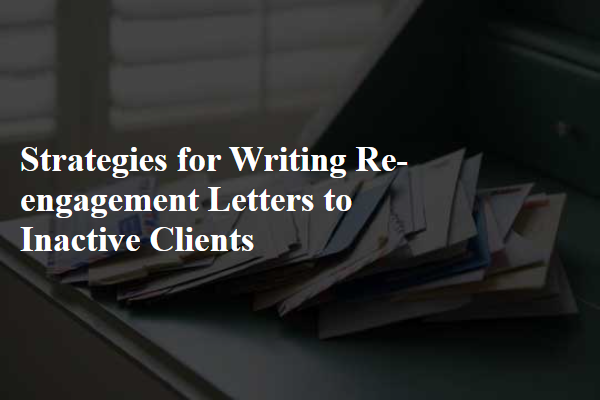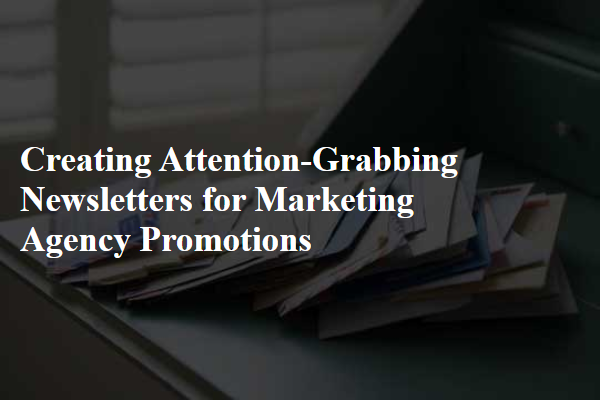
Craft personalized re-engagement letters by highlighting previous successes and offering exclusive incentives tailored to the client's needs. Use clear, compelling calls to action that encourage immediate response while emphasizing the value of renewed collaboration. Incorporate data-driven insights to demonstrate understanding of client behavior and to craft messages that resonate effectively.
Personalizing Your Re-engagement Approach
Crafting effective re-engagement letters to inactive clients requires personalized messaging that addresses their specific needs and past interactions. Use a warm tone to rebuild trust and demonstrate genuine interest in reigniting the business relationship.
Incorporate compelling calls-to-action that motivate clients to respond or take advantage of exclusive offers. Highlight recent company updates or new product benefits that align with their previous purchases to capture attention and drive engagement.
Highlighting New Services or Updates
How can businesses effectively re-engage inactive clients through targeted letters?
Writing personalized re-engagement letters can revive interest and rebuild client relationships. Focus on addressing clients' needs and offering value to encourage renewed engagement.
What key elements should be included in re-engagement letters for maximum impact?
Include personalized greetings, a reminder of past benefits, and clear calls to action. Incorporate incentives such as discounts or exclusive offers to motivate clients to return.
Why is timing critical when sending re-engagement letters to inactive clients?
Sending letters at the right time maximizes the chance of rekindling interest. Analyze client inactivity patterns to choose optimal intervals for communication.
How does personalization improve the effectiveness of re-engagement letters?
Personalization creates a connection by showing clients they are valued individually. Use client data such as purchase history or preferences to tailor content and offers.
What role does the tone of a re-engagement letter play in client response rates?
Maintaining a friendly, empathetic tone encourages positive reception and reduces resistance. Avoid aggressive sales language to foster trust and openness.
How can businesses measure the success of their re-engagement letter campaigns?
Track metrics such as open rates, click-throughs, and conversion rates to evaluate performance. Use insights to refine future communications and improve client retention strategies.
Leveraging Past Success Stories
Re-engagement letters to inactive clients should focus on personalized content that highlights the client's previous interactions and potential benefits of returning. Incorporating clear calls to action and exclusive offers can increase response rates effectively. Regularly analyzing client data to tailor the message ensures higher engagement and improved reactivation success.
Offering Exclusive Incentives
| Strategy | Description | Key Elements |
|---|---|---|
| Personalization | Tailor re-engagement letters to reflect the client's previous interactions and preferences. | Use recipient's name, reference past purchases or services, customize content based on client behavior. |
| Clear Value Proposition | Communicate compelling reasons for clients to return or respond to the offer. | Highlight exclusive discounts, new product launches, limited-time offers, or enhanced services. |
| Concise and Engaging Language | Keep the message brief but impactful to maintain the recipient's interest. | Use clear calls-to-action, friendly tone, avoid jargon, and be direct about next steps. |
| Timing and Frequency | Send re-engagement letters at optimal intervals to increase response rates without overwhelming clients. | Analyze customer inactivity duration, schedule follow-ups appropriately, avoid excessive messaging. |
| Incentives and Offers | Incorporate special deals or rewards to motivate inactive clients to re-engage. | Discount codes, free trials, loyalty points, gifts with purchase, personalized offers. |
| Easy Response Options | Make it simple for clients to reply or take the desired action from the re-engagement letter. | Include direct contact information, clickable links, reply buttons, or QR codes. |
| Feedback Request | Invite clients to provide input on why they became inactive or how services can improve. | Surveys, polls, open-ended questions, incentive for completing feedback. |
| Consistent Branding | Maintain visual and tonal consistency with the company's brand for recognition and trust. | Use company logo, brand colors, tone consistent with other communications. |
Addressing Common Barriers to Return
Re-engagement letters play a crucial role in renewing contact with inactive clients. Effective strategies focus on personalized messaging and clear value propositions to rekindle interest.
Start by addressing the client by name and referencing their past interactions with your business to create a personal connection. Highlight any new products, services, or offers that may benefit them and solve previous pain points. End with a strong call to action, such as scheduling a consultation or taking advantage of an exclusive discount.
Showcasing Industry Expertise and Credibility
Crafting effective re-engagement letters requires personalized messaging that highlights the client's past value and potential benefits of returning. Use clear, concise language that evokes positive emotions and trust.
Incorporate compelling subject lines and exclusive offers tailored to client preferences derived from previous interactions. Tracking response metrics and testing different approaches optimize future campaigns for higher success rates.
Crafting a Clear Call to Action
Re-engagement letters are essential tools for revitalizing relationships with inactive clients. Effective strategies focus on personalization, value offering, and clear calls to action to maximize response rates.
- Personalize Your Message - Tailor content to reflect the client's past interactions and preferences to create relevance and connection.
- Highlight Exclusive Offers - Present special deals or incentives to motivate clients to return and engage with your services.
- Include Clear Calls to Action - Use direct and straightforward instructions that guide clients on how to re-engage effectively with your business.
Demonstrating Value Proposition
Writing effective re-engagement letters to inactive clients requires strategic communication to rekindle interest and restore business relationships. Employing personalized, value-driven content can significantly increase response rates and client retention.
Successful re-engagement strategies focus on clarity, personalization, and compelling calls to action that inspire clients to reconnect with your brand.
- Personalize the message - Tailor the letter using the client's name and past purchase history to create a sense of individual attention.
- Offer value incentives - Include exclusive discounts or offers that encourage clients to take immediate action.
- Include a clear call to action - Provide straightforward instructions or simple steps that make it easy for clients to respond or re-engage.
Requesting Feedback or Insights
Writing re-engagement letters to inactive clients requires personalized messaging that highlights recent updates or offers tailored solutions to their needs. Use clear subject lines that capture attention and express genuine interest in reconnecting. Incorporate a strong call to action, encouraging clients to respond or take advantage of special incentives to renew the relationship.
Creating Urgency with Limited-Time Offers
Writing effective re-engagement letters to inactive clients requires targeted strategies to capture their interest and rebuild trust. These letters should be clear, personalized, and provide tangible value to encourage reactivation.
- Personalization - Tailor the message to reflect the client's past interactions and preferences to create a sense of individual attention.
- Compelling Offers - Include exclusive discounts or incentives that motivate clients to resume business.
- Clear Call-to-Action - Use straightforward instructions or links that guide clients on how to re-engage quickly and easily.
Consistent follow-up and monitoring response rates enhance the overall success of re-engagement campaigns.



Comments